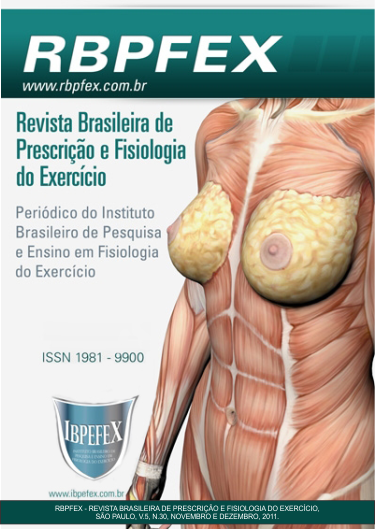Analysis of cardiac overload training in different intensities
Abstract
The cardiovascular system is among the organic systems, one of the most changes during the practice exercise. An indicator to indirectly determine the rate of myocardial infarction is the rate pressure product (RPP), which is the product of heart rate (HR)and systolic blood pressure (SBP). The purpose of this study was to analyze these variables in three different intensities of resistance exercise training. The study consisted of six volunteers who underwent a protocol of three series specific repetition maximum (RM), divided into 6RM, 12RM and 25RM, with one minute between sets on the leg press 45º aparrathus. The results showed significant difference in SBP between the first and the other series in 12RM. They also found differences between 6RM and 25RM in second set. In the same RM, the HR was different between the first and third series in 25RM. When comparing the RM, we obtained a difference in the first and second series between 12RM and 25RM. Moreover, in third grade the intensity of 25RM was higher when compared to others RM. The RPP was different between the first and the other series in 12RM. There was a difference between 12RM and 25RM in the first series, the intensity of 25RM was different in the second and third series when compared to the other. According to the results, we concluded that the intensity of 25RM had a higher cardiac overload, when compared to other intensities studied.
References
-Araújo, G.S.; Klein, C.M.O. Respostas cardiovasculares agudas no exercício leg-press em idosos utilizando diferentes protocolos de treinamento. Revista Brasileira de Prescrição e Fisiologia do Exercício. Vol. 4. Num. 21, 2010. p. 245-251.
-D'Assunção, W.; Daltro, M.; Simão, R.; Polito, M.D., Monteiro, W. Respostas cardiovasculares agudas no treinamento de força conduzido em exercícios para grandes e pequenos grupamentos musculares. Revista Brasileira de Medicina do Esporte Vol. 13. Num. 2. 2007. p. 118-122.
-Diretrizes do ACSM para os testes de esforço e sua prescrição. Rio de Janeiro: Guanabara Koogan. 2010.
-Farinatti, P.T.V.; Assis, B.F.C. Estudo de freqüência cardíaca, pressão arterial e duplo-produto em exercícios contra-resistência e aeróbio contínuo. Revista Brasileira de Atividade Física e Saúde. Vol. 5. Num. 2. 2000. p.
-16.
-Forjáz, C.L.M.; Rezk, C.C.; Melo, C.M.; Santos, D.A.; Teixeira, L.; Nery S.S. Exercício resistido para o paciente hipertenso: indicação ou contra-indicação. Revista Brasileira de Hipertensão. Vol. 10. Num. 2. 2003. p. 119-124.
-Fornitano, L.D.; Godoy, M.F.D. Duplo produto elevado como preditor de ausência de coronariopatia obstrutiva de grau importante em pacientes com teste ergométrico positivo. Arquivos Brasileiros de Cardiologia. Vol. 86. Num. 2. 2006. p. 138-144.
-Gotshall, R.W.; Gootman, J.; Byrnes, W.C.; Fleck, S.J.; Valovich, T.C. Noninvasive characterization of the blood pressure response to the double-leg press exercise. Journal of Exercise Physology. Vol. 2. Num 4. 1999. p. 1-6.
-Guyton, A.C.; Hall, J.E. Tratado de fisiologia médica. Rio de Janeiro: Guanabara Koogan, 2002.
-Kleiner, D.M.; Blessing, D.L.; Mitchell, J.W.; Davis, W.R. A description of the acute cardiovascular response to isokinetic resistance at three different speeds. Journal Strength and Condition Research. Vol. 13. 1999. p. 360-366.
-Leite, T.C.; Farinatti, P.T.V. Estudo da freqüência cardíaca, pressão arterial e duplo produto em exercícios resistidos diversos para grupamentos musculares semelhantes. Revista Brasileira de Fisiologia do Exercício. Vol. 2. 2003. p. 29-49.
-Lopes, L.T.P.;Gonçalves, A.; Rezende, E.S. Resposta do duplo produto e pressão arterial diastólica em exercícios de esteira, bicicleta estacionaria e circuito na musculação. Revista Brasileira de Cineantropometria e Desempenho Humano. Vol. 8. Num. 2. 2006. p. 53-58.
-Lopes Maria, J.B.; Gonçalves, A. Respostas agudas e crônicas da pressão arterial após exercícios aeróbicos e resistidos: uma breve revisão dos estudos de autores brasileiros. EFDeportes.com. Num. 139. 2009. p. 1-7.
-Polito, M.D.; Farinatti, P.T.V. Respostas de frequência cardíaca, pressão arterial e duplo-produto ao exercício contra-resistência: uma revisão da literatura. Revista Portuguesa de Ciências do Desporto. Vol. 3. Num. 1. 2003. p. 79-91.
-Pollock, M.L.; Franklin, B.A.; Balady, G.J.; Chaitman, B.L.; Fleg, J.L.; Fletcher B. Resistance exercise in individuals with and without cardiovascular disease. Circulation. Vol. 101. 2000. p. 828-833.
-Powers, S.K., Howley, E.T. Fisiologia do Exercício: teoria e aplicação ao condicionamento e ao desempenho. São Paulo: Manole. 2005.
-Souza, F.R.; Lopes L.T.P.; Gonçalves A. Avaliar respostas cardiovasculares em métodos de treinamento diferenciados. EFDeportes.com. Num. 142. 2010. p. 1-6.
Authors who publish in this journal agree to the following terms:
- Authors retain the copyright and grant the journal the right of first publication, with work simultaneously licensed under the Creative Commons Attribution License BY-NC which allows the sharing of the work with acknowledgment of the authorship of the work and initial publication in this journal.
- Authors are authorized to enter into additional contracts separately for non-exclusive distribution of the version of the work published in this journal (eg, publishing in institutional repository or book chapter), with acknowledgment of authorship and initial publication in this journal.
- Authors are allowed and encouraged to post and distribute their work online (eg, in institutional repositories or on their personal page) at any point before or during the editorial process, as this can bring about productive change as well as increase impact and impact. citation of published work (See The Effect of Free Access).






